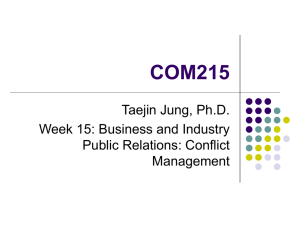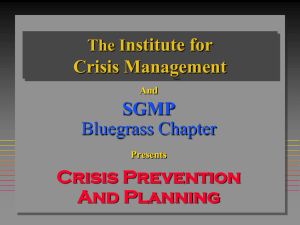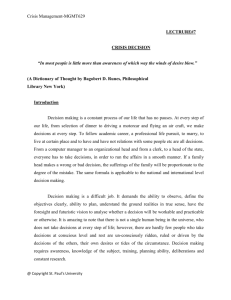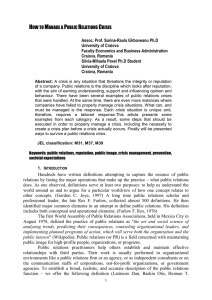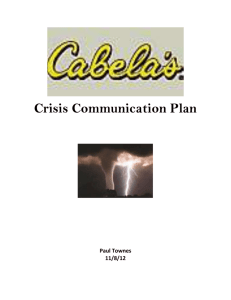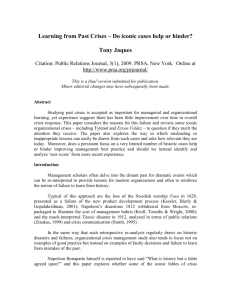Crisis Communication Research Paper
advertisement
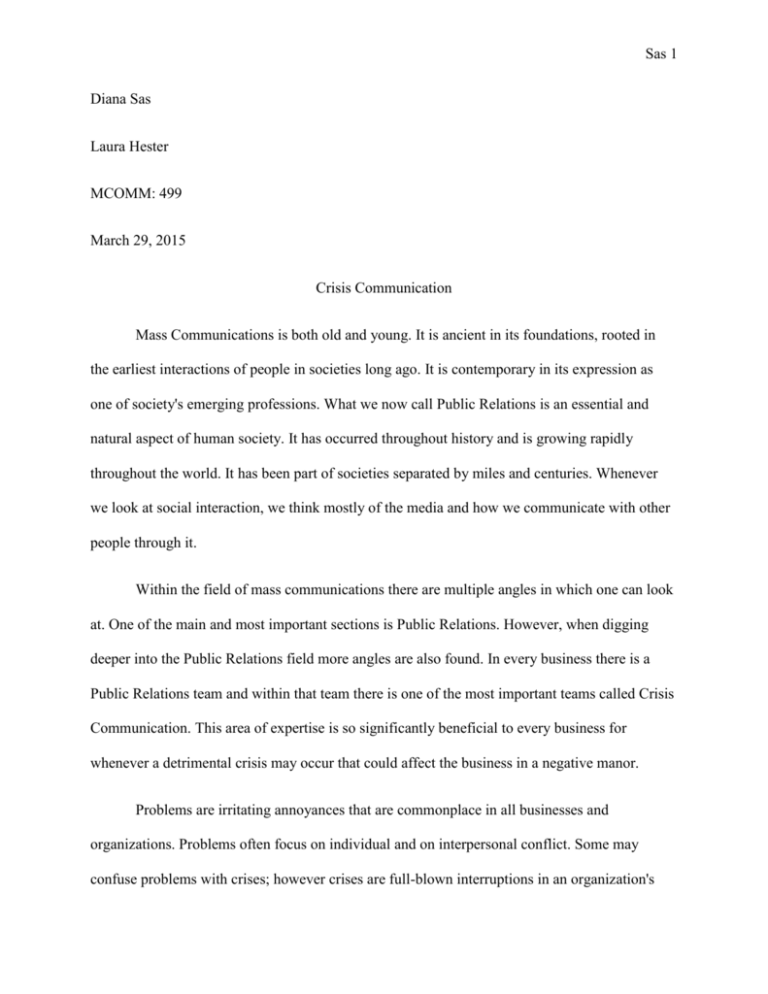
Sas 1 Diana Sas Laura Hester MCOMM: 499 March 29, 2015 Crisis Communication Mass Communications is both old and young. It is ancient in its foundations, rooted in the earliest interactions of people in societies long ago. It is contemporary in its expression as one of society's emerging professions. What we now call Public Relations is an essential and natural aspect of human society. It has occurred throughout history and is growing rapidly throughout the world. It has been part of societies separated by miles and centuries. Whenever we look at social interaction, we think mostly of the media and how we communicate with other people through it. Within the field of mass communications there are multiple angles in which one can look at. One of the main and most important sections is Public Relations. However, when digging deeper into the Public Relations field more angles are also found. In every business there is a Public Relations team and within that team there is one of the most important teams called Crisis Communication. This area of expertise is so significantly beneficial to every business for whenever a detrimental crisis may occur that could affect the business in a negative manor. Problems are irritating annoyances that are commonplace in all businesses and organizations. Problems often focus on individual and on interpersonal conflict. Some may confuse problems with crises; however crises are full-blown interruptions in an organization's Sas 2 routine that can negatively and severely impact its success and its reputation. A crisis is a major, negative, public, sudden, and unpredicted event that can seriously disrupt an organization's activity and potentially hurt the organization tremendously. Because a crisis occurs in a public environment, even private businesses and nonprofit organizations cannot shield themselves from the expectation of being accountable. By its nature, a crisis invites outside scrutiny and jeopardizes the organization's reputation. An organization may find itself either in the role of either culprit or victim in a crisis situation. Regardless of the cause, if a crisis is handled properly, it offers the organization with an opportunity to create a positive impression on its key publics. Some of the major types of crises include; violent disaster such as an earthquake or flood, non-violent disaster such as drought or epidemic, violent accident such as mishap involving people or equipment, mismanagement such as bad professional judgement involving operations and procedures, violent opposition including impact by outside forces such as tampering or terrorism, and non-violent opposition such as erosion of public trust, lawsuits, and protests. Another way of categorizing crises is sudden verses smoldering. Sudden crises burst upon the scene without warning and can become very messy when trying to settle the situation. Fortunately this is seldom the case for businesses and organizations. Smoldering crises are much more common and can be easier to handle when approached. Every business and organization entrusts all responsibility when a crises occurs to the Crisis Communication team. Each team is required to have a set plan for action when a crises strikes. A crisis plan seeks to defend that reputation in adverse situations. It has been known in history for some Crisis Communication teams to fail at having a plan that is effective and the consequence for this is very severe. The main idea of Crisis Communication is to maintain the Sas 3 reputation, trust, and visibility of the company to its publics. Crisis management is both a proactive and reactive process of planning strategically to anticipate crises and to handle them effectively at each stage: detection, prevention or preparation, response, and recovery. A Crisis Management team is incredibly substantial to a business, company, or organization. This group should have senior managers initiate and supervise issues management, develop a crisis plan, see that appropriate training and resourcing is available, and continually press the issue of crisis preparedness and management. This allows an organization to prevent problems or minimize their impact by being prepared to deal with them. For a crisis plan to be effective, it must be personalized to the specific needs of an organization. One major task of a crisis management team is to provide training for organizational leaders in how to handle themselves situations such as media interviews, news conferences, and other public presentations if a crisis were to arise. This often is a task for an outside consultant experienced in the three areas of journalism, public relations and training. As stated above, there have been moments in history where a Crisis Management team has failed at creating a successful crisis plan. For example Hurricane Katrina struck New Orleans in 2005 resulting in Levee breaches leading to massive flooding, and many people charged that the federal government was slow to meet the needs of the people affected by the storm. Hundreds of thousands of people in Louisiana, Mississippi and Alabama were displaced from their homes, and experts estimate that Katrina caused more than $100 billion in damage. The devastation was impulsive in the sense of the details of the storm. However for years, there had been warning of potential weaknesses in the levies, inadequacy of evacuation plans, flaws in the emergency communication systems, and politicization of the Federal Emergency Management Agency. Three years later when Hurricane Gustav hit the same area, some of the levies had been Sas 4 improved, evacuation plans were in place, the communication system had been shored up and FEMA operated more effectively. The lesson to be learned was if the organization had implemented a program of monitoring the internal and external environments, steps could have been taken to prevent or significantly minimize the eventual damage. Another case study of a failed crisis plan occurred in 1989 when 11 million gallons of oil spilled into Prince William Sound, Alaska. This crisis left 500,000 birds/150 bald eagles, 4,500 sea otters, 14 killer whales dead and took a huge toll on fishing & tourism. The mistakes made by the Crisis Management Team left low-profile Companies suspicious of media reports. For example the first public comment was made after 6 days, no one was on site for 3 weeks, there was no designated spokesperson to handle the situation. The Exxon companies’ stock dropped $3 billion, a newspaper apology was available in ads 10 days later and there was a two-week delay before cleanup. The lesson to be learned was to take faster action, don’t execute the situation with silence, and have priority of profits over consumer. This crisis was a great example of a crisis management team that chose arrogance, and putting the blame on others, which in result ruined the reputation and trust of the public for Exxon. The most rewarding and honorable case study of good crisis management occurred in 1982 when seven Chicago residents died & 250 got sick after ingesting cyanide-laced Tylenol capsules, which had been tampered with on the store shelves. The company put customer safety first. They pulled 31 million bottles of Tylenol, which came out to be $100 million in Tylenol products. All advertising and production of the product was pulled from the shelves and put to a halt. The Chicago police, FBI and FDA were all involved in a search to find the killer and a $100,000 reward was offered for who found this person. Post-crisis, the company reintroduced Tylenol with new tamper-resistant packaging and $2.50-off coupons. As a result to this crisis in Sas 5 1982 “A go-to case study in MBA classes worldwide, Tylenol's response to the tragic 1982 Chicago murders is regarded as one of the most successful sequences of crisis management in history. The media appreciated the lengths J&J went to and its concern for the public interest, so the company was portrayed generally in a good light, helping the Tylenol brand to recover.” The lesson to be shared with this crisis was quick action, proactive communication and priority of consumer over profits. Overall Crisis Communication is one of the most important groups of a business or organization. This team oversees all crises when they strike and are required to be well prepared for any given situation. As long as a crisis management team can understand the role of corporate communications, recognize issues that might impact an organization’s survival and realize the power of the U.S. news media, in particular the “social” media and its application in today’s crisis environments then a company will be well protected. It is also beneficial to ensure this team has media relations skills and can critically analyze previous crisis situations in established organizations. If all crisis communication management teams can demonstrate these actions then all companies will benefit successfully. Sas 6 Work Cited "Questions and Answers." Oil Spill Facts. Web. 30 Mar. 2015. <http://www.evostc.state.ak.us/index.cfm?FA=facts.QA>. Bhasin, Kim. "9 PR Fiascos That Were Handled Brilliantly By Management." Business Insider. Business Insider, Inc, 26 May 2011. Web. 20 Nov. 2014. <http://www.businessinsider.com/pr-disasters-crisis-management-2011-5?op=1>. "Hurricane Katrina." History.com. A&E Television Networks. Web. 30 Mar. 2015. <http://www.history.com/topics/hurricane-katrina>.
